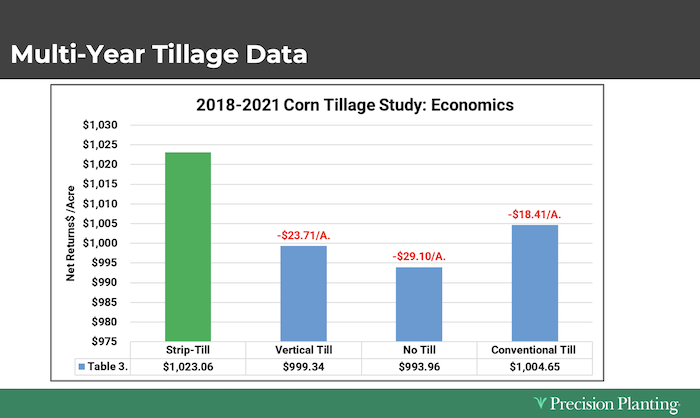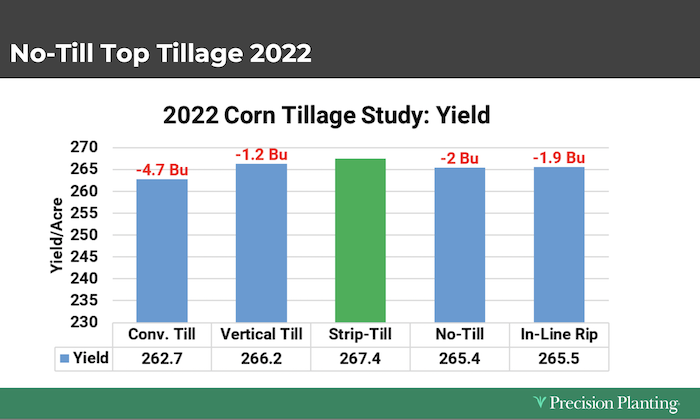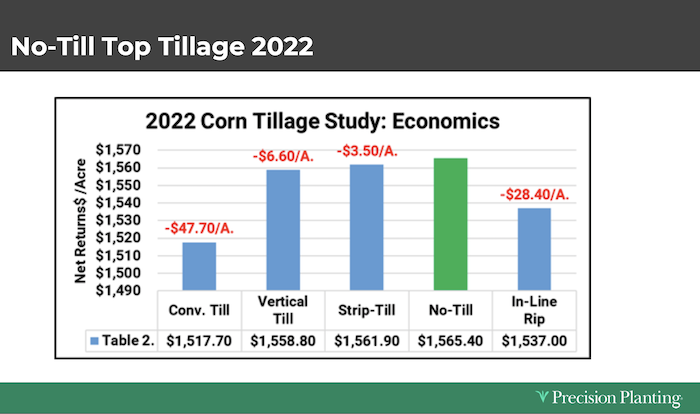Jason Webster is a farmer and the lead commercial agronomist for the Precision Technology Institute (PTI) for Precision Planting in Pontiac, Illinois. Webster and his team conducted 160 agronomy trials at the PTI’s 400-acre research farm in 2023, and hosted thousands of visitors from around the world to share their results.
Webster's team has collected 5 years of data from an annual study comparing the yield and economics of strip-till, no-till, vertical tillage and conventional tillage.
“Every one of these tillage programs has a system cost which is calculated into this,” Webster says. “With no-till, for example, you're not burning lots of fuel, but you're going to have more of a burndown expense. Conventional tillage obviously would have more fuel and heavy horsepower. That's all factored into the system cost for each of these.”
In the no-till plot, researchers planted directly into the previous year’s stubble; herbicide was used as a burndown to control weeds in the absence of tillage, Webster says.
In the vertical tillage plot, vertical tillage was used to mix, cut and level residue at a depth of 2 inches after harvest; a burndown herbicide was used here too.
The strip-till plot saw 10-inch-deep strips created with a strip-till unit, followed by a burndown herbicide.
Finally, the conventional tillage plot saw 13-inch ripping with aggressive cutting and residue mixing; a spring soil finisher leveled before planting.
The researchers applied the same rate of broadcast dry fertilizer in each plot.
Between 2018-2021, the data points to strip-till as the most economical system, with average net returns of $1023.06 per acre, followed by conventional tillage at $1004.65 per acre, vertical tillage at $999.34 per acre and no-till in last place at $993.96 per acre.

There’s more to the story with no-till, Webster says. He attended the 2023 National No-Tillage Conference in January, and asked veteran no-tillers why his no-till plot was performing so poorly.
They asked him what kind of tillage had been practiced on the land before he’d started the PTI farm. The land had been under conventional tillage, responded Webster, for 50-60 years.
“They said, ‘Wait a minute, you mean to tell me this farm had been conventional tillage for 50-60 years. You walk in on year number one, and you shove it right into no-till?’ I said, ‘Are you inferring that there could be some time involved here, where there's a healing process that has to happen before no-till or reduced tillage can be successful?’ And they said, ‘Exactly.’”
It would take at least 5 years before the no-till plot’s numbers would start to look good, they said.
“And that's what I've got going on with my data,” Webster says. “Because even though the 5-year data would say no-till was terrible, strip-till was my highest yielder overall, but when you put the system cost into this, for the first time on the PTI Farm, no-till actually won on a dollar per acre basis in 2022. It took 5 years to get it there, but it did.”
In terms of yield, in 2022, strip-till performed best at 267.4 bushels per acre, followed by vertical-till at 266.2 bushels per acre, no-till at 265.4 bushels per acre and conventional tillage at 262.7 bushels per acre.

But in terms of overall economics, no-till came out on top at $1565.40, followed by strip-till ($1561.90), vertical tillage ($1558.80) and conventional tillage ($1517.70).

Can no-till win over the long term? That’s the question, says Webster. “That's how I'm treating no-till right now. Okay, you won for the first time. Now you’ve got to do it again in 2023.”






